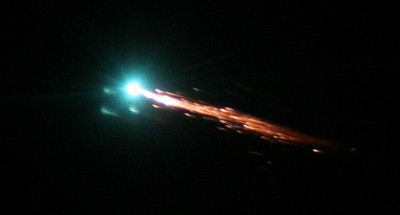[/caption]
The bus sized UARS (Upper Atmosphere Research Satellite) is expected to re-enter Earth’s atmosphere early morning GMT on September 24. Right now, the Center for Orbital and Reentry Debris Studies lists the projected re-entry time as 05:10 UT on Sept. 24, plus or minus 2 hours.
NASA UPDATE “As of 7 p.m. EDT on Sept. 23, 2011, the orbit of UARS was 90 miles by 95 miles (145 km by 150 km). Re-entry is expected between 11 p.m. Friday, Sept. 23, and 3 a.m., Sept. 24, Eastern Daylight Time (3 a.m. to 7 a.m. GMT). During that time period, the satellite will be passing over Canada, Africa and Australia, as well as vast areas of the Pacific, Atlantic and Indian oceans. The risk to public safety is very remote.”
Due to the robust nature of some of the parts on the satellite, it is likely that approximately 500kg of material will impact the ground or water.
The FAA (Federal Aviation Administration) has released a Local Air Safety Information special notice advising of the possibility of space debris.
The calculated risk that you’ll be hit by the falling space debris has been put at 1 in 3,200, said Nick Johnson, chief scientist with NASA’s Orbital Debris Program. But the chance that any one person on Earth getting hit by debris has been estimated at about 1 in 21 trillion.
It is highly unlikely that any injury or damage will be caused by this falling debris and NASA says; “The risk to public safety or property is extremely small, and safety is NASA’s top priority. Since the beginning of the Space Age in the late-1950s, there have been no confirmed reports of an injury resulting from re-entering space objects. Nor is there a record of significant property damage resulting from a satellite re-entry.”
It is still unsure where exactly the UARS satellite will pass over and re-enter the Earth’s atmosphere, but it will be an incredibly bright fireball visible even in daylight. But if some debris ends up near you, don’t worry too much — it won’t be flaming hot. NASA says any pieces of UARS landing on Earth will not be very hot. The heating of objects passing through the atmosphere stops at about 32 km (20 miles) up, and cools after that.
Stay posted for more updates and if you are lucky enough to get an image of UARS burning up please let us know and post your images on our flickr group


Is there a live tracker somewhere?
http://www.lizard-tail.com/isana/tracking/?target=uars
Try http://www.n2yo.com/
The server is very slow (overwhelmed ?)
I have a bigger chance to be hit than anyone else? Wow!
in Italy the media are saying it will fall here, about at 2 o’clock in the morning of sat CET. yes here, and we’re praying that it beat Berlusconi’s house 🙂 So don’t worry, it’ll not surely reach the Us, ciao,
Franco
in Italy the media are saying it will fall here, about at 2 o’clock in the morning of sat CET. yes here, and we’re praying that it beat Berlusconi’s house 🙂 So don’t worry, it’ll not surely reach the Us, ciao,
Franco
“The calculated risk that you’ll be hit by the falling space debris has been put at 1 in 3,200, said Nick Johnson, chief scientist with NASA’s Orbital Debris Program. But the chance that any one person on Earth getting hit by debris has been estimated at about 1 in 21 trillion.”
This is a misquotation, not to mention makes no sense. What Johnson actually said was that debris has a 1 in 3,200 chance of hitting SOMEONE, and I think what he actually meant was it has a 1 in 3,200 chance of causing injury or property damage. Odds are it’s going to hit water, but it is still much more likely to cause property damage than injury, since most people are inside most of the time.
I want to get a piece of it. I’m sitting on my porch with a baseball glove.
I think you have an error there. When you say that solar activity has decreased and is no longer slowing the satellite’s rate of descent, I think it’s the other way around. Lower solar activity means lower atmospheric density at high altitudes, which means lower drag, which means lower descent rate. Higher solar activity would speed descent rate. Therefore the sentence should read: “Additionally, solar activity has decreased and is no longer speeding the satellite’s rate of descent.”
UARS Satellite passed ENE of Kelowna, BC about 15 – 20 min ago
Visible with binoculars. Luminance was varying rapidly, which is why I noticed it.
can i get some piece of it
NASA Satellite Crashing on Earth Alerts http://itwel.com/nasa-satellite-crashing-on-earth-alerts.php